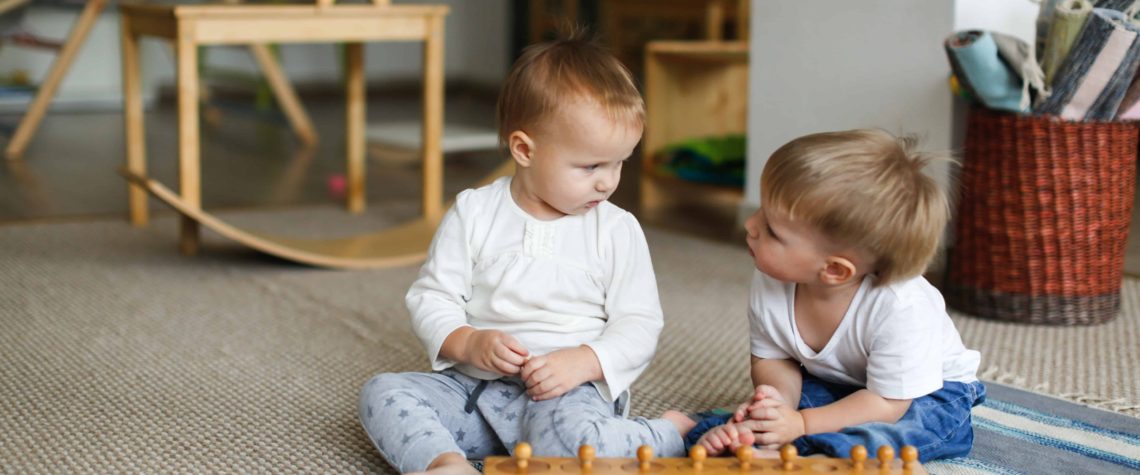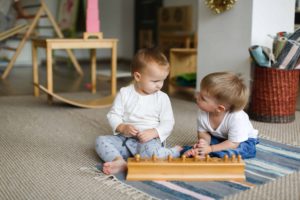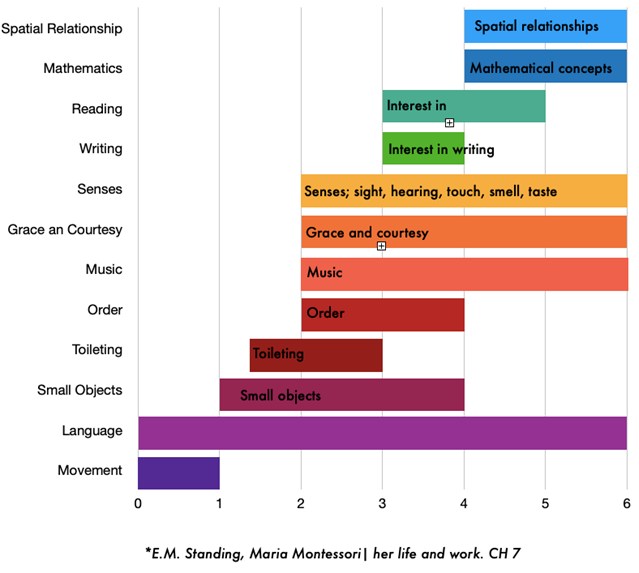Stages of early childhood development
You might have noticed your child between the ages of 1-3 get extremely frustrated when things happen slightly out of order to them. This could look like finishing diapering and wanting to flush the toilet but missing the opportunity, or not being able to throw the dirty diaper in the bin afterwards. Whatever it may be, a tantrum ensues with a resolute toddler, and everything else must wait. If most basic needs are met, this is likely because they are in one of their sensitive periods, the sensitive period for order.
Children experience different stages of sensitive periods throughout their childhood at specific times between birth to age six. After reading this short blog you will know exactly what a sensitive period is, and how they affect infant/toddler development. Aided with Montessori quotes, and examples of sensitive periods in child development, you will also find twelve stages of sensitive periods in chart form below. Let’s dig in!
What is a sensitive period?
What we defined as a base-less tantrum earlier, is actually an intense sensitivity to order, a child’s innate desire to have this order, and their response to the missing the order. Here is what Montessori means by sensitive period;
“A sensitive period refers to a special sensitivity which a creature acquires in its infantile state, while it is still in a process of evolution. It is a transient disposition and limited to the acquisition of a particular trait. Once this trait, or characteristic, has been acquired, this special sensitivity disappears”
Montessori, The Secret of Childhood, p. 38
Sensitive periods in child development are described as time frames when children are highly receptive to certain stimuli in their environment, aiding in their brain, mind, and organ developmental processes.
How does this effect infant and toddler development?
During these transitory and definite periods children can show phenomenal capabilities in skills, physical development, and cognitive development stemming from the sensitivity. As the child experiences this sensitivity they repeat a specific activity or behavior until they have mastered the skill. This is why around the ages of two and half, children have a burst of language and talk nonstop. They are in their sensitive period for language, the muscles around their mouth are strengthening and establishing pathways to corresponding neurons in the brain. At this time the child is able to learn much more new vocabulary, sentence structure, and categorizing strategies than he was before. He can even pick up a second language seamlessly.
Characteristics of sensitive behavior
Other characteristics of sensitive periods include repetitive behaviors like opening and closing, hiding and finding, intense concentration and focus on a task (not to be interrupted!), mimicking others, and moving for the sake of it.
What to do during sensitive periods
Providing stimuli during a sensitive period will allow the child to flourish in later years of life. Conversely, instructing the child to learn complex concepts, before the sensitivity period has arrived, can have a deterring effect on their disposition towards learning them when the time comes. Instructing them after the sensitivity period has passed, might be too late for optimal learning. Therefore as caregivers, recognizing sensitive periods can be extremely beneficial for further child development, we certainly don’t want to miss these crucial windows of opportunity. (see chart below for ages and stages).
Furthermore, Montessori believes humans learn most of what they will ever learn, during the first two years of their life, even though sensitive periods last from birth till age six.
“The acquisitions he has made are such that we can say the child who enters school at three is an old man. Psychologists say that if we compare our ability as adults to that of a child it would require us 60 years of hard work to achieve what a child has achieved in the first three years…a child at three is already an old man.” Montessori, The absorbent mind, p 5., KDP chapter 1.
What we should do is provide a nurturing, consistent and supportive environment. Children learn through experiences in their environment whether we teach them or not. Each child’s inner light is naturally pushing them to interact with their surroundings. Montessori adds;
“Our school is not a real school; it is a house of children, i.e., an environment specially prepared for the children, where children absorb whatever culture is spread in the environment without anyone teaching them.”
Montessori, The absorbent mind, p 6. e-book, KDP.
Strategies Montessorians use to guide learning
- Observation plays a key role in identifying sensitive periods in children. Montessori guides are aware of signs of readiness and continuously observe their classroom environment.
- They wait patiently for children to show interest or a natural inclination to perform certain skills, before introducing them to new concepts.
- Montessori encourages the environment of children be designed and modified catering to needs they have specifically during their current sensitive periods. The materials are manufactured keeping the child’s absorbent mind, and human tendencies into account.
Other sensitive periods
The twelve sensitive periods (officially six by Maria Montessori) identified by Montessorians around the world today are; order, movement, language acquisition, writing, reading, sensory impressions, music, small objects, grace and courtesy, spatial relationships, mathematics and most importantly, toileting. Below is a chart showing when these periods occur during childhood.


